Describe briefly the location, size and shape of prostate.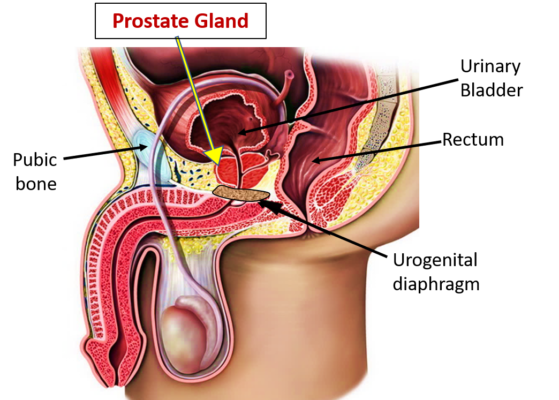
Prostate is a pyramidal shaped fibromuscular and glandular organ. It is an accessory sex gland in males. It becomes functionally active at the time of puberty and its secretions ( acid phosphatase, fibrinolysin, citric acid, protaglandins) form the bulk of seminal fluid.
Location: It is located in the lower part of the pelvic cavity. It lies below the neck of the urinary bladder and above the urogenital diaphragm. It is behind the lower part of pubic symphysis and in front of the rectum. It surrounds the prostatic part(initial 3 cm.) of urethra.
Shape: It resembles an inverted cone with broad base upward and pointed apex downwards.
Size: Is of the size of a walnut. Length – 3cm, Breadth – 4cm, Weight – 8cm and thickness-2cm (Length is smaller than the Width).
Describe gross features and relations of prostate.
Gross features and Relations: Prostate gland has:
• Apex: It is directed downwards between the medial margins of levator ani muscles. It rests on the superior fascia of urogenital diaphragm.
• Base: It is directed upwards. It surrounds the neck of the urinary bladder and is pierced by urethra near its anterior surface.
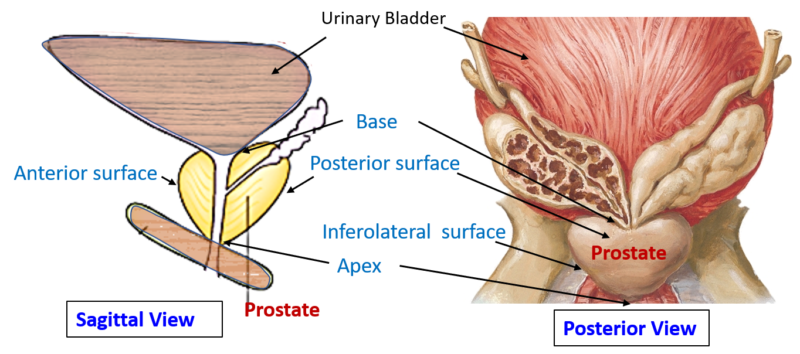
Four surfaces:
- Anterior surface: Is narrow and convex. Is separated from the pubic symphysis by extraperitoneal fat of retropubic space (Cave of Retzius) containing – prostatic venous plexus, deep dorsal vein of penis and puboprostatic ligaments.
- Posterior surface: Is broad, flat and triangular.It is separated from the ampulla of rectum by the rectovesical fascia ( fascia of Denonvilliers). It is divided by a horizontal groove into smaller upper part (median lobe) and larger lower part (further divided by median sulcus into two lateral lobes). The ejaculatory ducts (formed by joining of ductus deferens and duct of seminal vesicle ) pierce the horizontal sulcus near the median plane.
- Two inferolateral surfaces: Are related to levator ani muscle.
Describe the capsules of prostate.
Prostate gland is surrounded by two capsules outer false and inner true capsule.
True capsule: It is formed by condensation of the fibrous stroma of the gland. It is adherent to the prostate gland.
False capsule: It is formed by condensed pelvic fascia.
* Prostatic venous plexus lies between the true and false capsule.
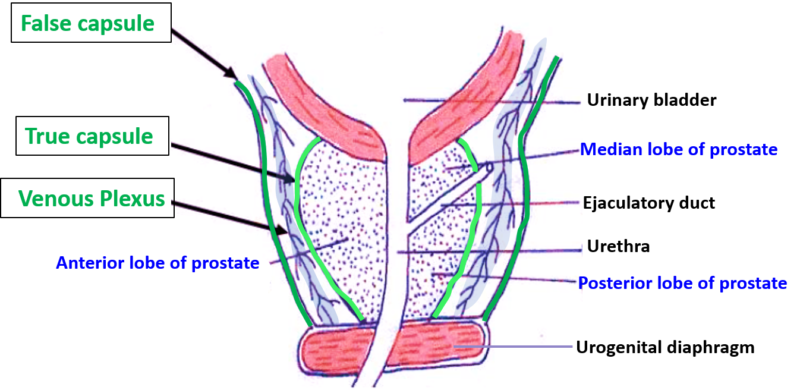
Describe briefly the structures within the prostate and the lobes of prostate.
Following are the structures present in the interior of prostate: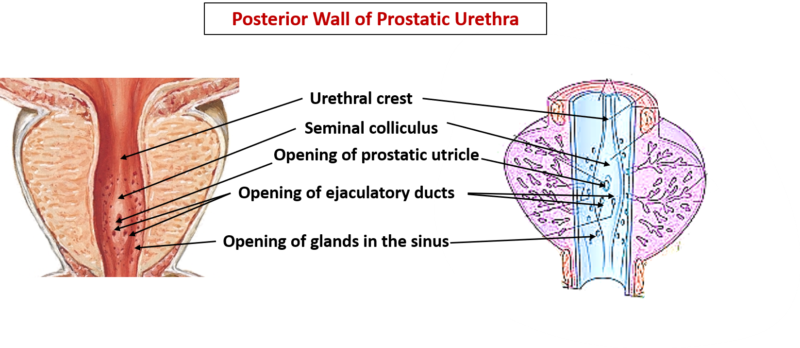
Prostatic urethra
It pierces the base of the prostate, passes vertically downwards and leaves it a little above and in front of its apex. It is nearer to the anterior surface than the posterior surface. It is the widest and most dilatable part of the male urethra. Its posterior wall presents:
- Urethral crest : longitudinal ridge in the midline.
- Colliculus Seminalis (verumontanum): Is an elevation at the middle of the urethral crest which has 3 openings :
- opening of prostratic utricle in the middle.
- two openings of ejaculatory ducts on either side of the opening of prostatic utricle.
Prostatic sinuses
These are the two longitudinal grooves on either side of the urethral crest. About 15 to 20 prostatic ducts into the sinuses and pour the secretion of the prostate into the urethra
Ejaculatory ducts
They enter the gland posterolateral to the median lobe and open in the prostatic urethra.
Prostatic utricle
It is a blind sac, approximately 6mm long which extends upwards and backwards from the prostatic urethra, behind the median lobe ( it is remnant of paramesonephric duct).
Lobes of Prostate
Prostate gland is divided into five lobes by the prostatic urethra and ejaculatory ducts.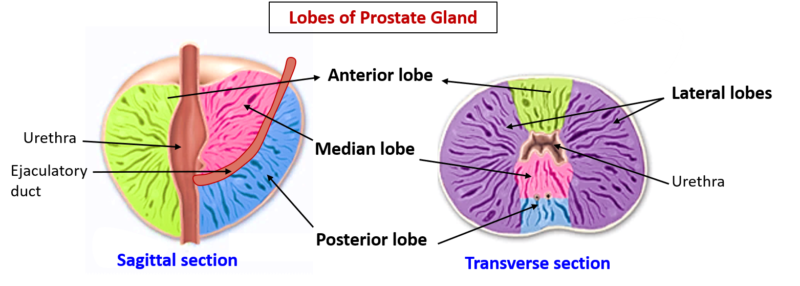
- Anterior lobe: Lies anterior to urethra (formed by a small part called isthmus connecting the two lateral lobes). It is mainly formed of fibromuscular tissue. Adenoma rarely occurs in this lobe.
- Posterior lobe: Lies behind the urethra and the median lobe and below the ejaculatory ducts. Adenoma never occurs but primary carcinoma may begin here.
- Median lobe: Lies behind the urethra and above the ejaculatory ducts. It forms the uvula vesicae, an elevation in the lower part of the trigone of bladder behind the internal urethral meatus. It is the common site of adenoma.
- Right and left lateral lobes: Lie on each side of the urethra. Contain glandular tissue and adenoma may arise in old age.
Describe the glandular tissue of prostate.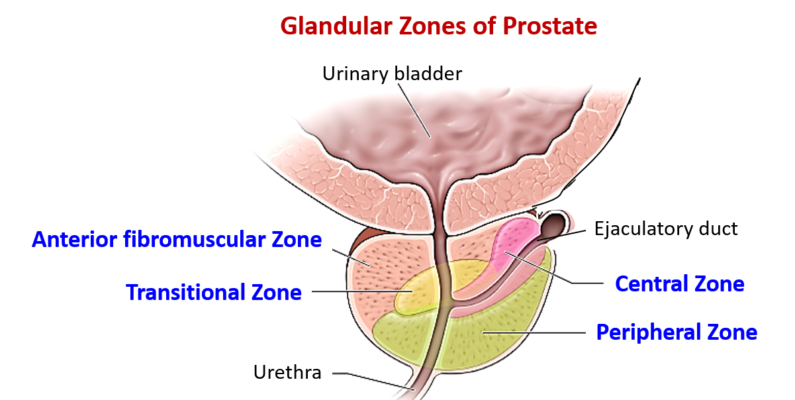
Glandular tissue of prostate is arranged in three concentric layers or zones.
- Peripheral zone: It consists of long branching glands whose ducts open into the prostatic sinuses below the level of colliculus seminalis. Glands in this zone develop from endoderm and are prone to carcinoma.
- Transitional zone: It consists of submucosal glands whose ducts open in the prostatic sinuses at the level of colliculus seminalis. Glands in this zone are mesodermal in origin and they are prone to benign hypertrophy of prostate (BHP).
- Central zone: Consists of mucosal glands surrounding the of the ejaculatory ducts at upper part and prostatic urethra.*Anterior fibro-muscular zone: This zone is usually devoid of glandular components and is composed only of muscle and fibers.
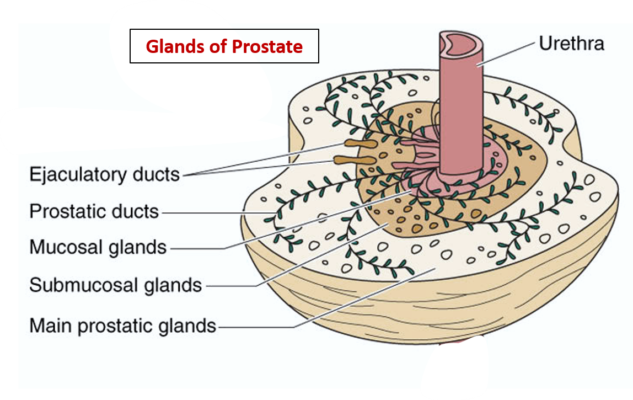
Enumerate the arteries supplying prostate.
Arteries supplying prostate are branches of internal iliac artery viz.:
- Inferior vesicle artery
- Internal pudendal artery
- Middle rectal artery
Enumerate the lymph nodes into which lymph from prostate drains.
- Mainly into internal iliac lymph nodes.
- Some lymphatics from posterior surface drains into sacral and external iliac lymph nodes.
Describe briefly the venous drainage of prostate gland.
The veins draining the prostate form prostatic venous plexus which is located between the true and the false capsule of the prostate gland. The venous drainage of prostate may follow the following two routes:
- Prostatic venous plexus -> into Internal iliac vein -> into Common iliac vein -> into Inferior venacava.
- Prostatic venous plexus -> Vertebral venous plexus of Batson -> Intracranial dural venous sinus. This route explains metastasis of prostate cancer to vertebral column and brain.
What age related changes occur in prostate gland?
The age related changes in prostate gland are as follows:
- In newborn and childhood: Prostate has fibromuscular stroma and only rudiments of duct system.
- At pubery: There is spurt of growth glandular tissue under the influence of testosterone. The prostatic glands develop, proliferate and begin secretion.
- During third decade: Irregular epithelial infoldings in the lumen make the gland irregular.
- During fourth decade: The epithelial infoldings gradually disappear and amyloid concretions start forming in the glands.
- During and after fifth decade: the prostate may show benign hypertrophy or progressive atrophy.
Applied Aspects
Benign Hypertrophy of prostate (BHP)
It commonly involves the median lobe, which projects into the urinary bladder and may obstruct the urinary outflow. As the patient strains to micturate, the enlarge uvula vesicae blocks the internal urethral orifice.
Surgical removal of prostate gland
In surgical removal of benign (adenomatous) hypertrophy of prostate, the normal peripheral part is compressed into a capsule surrounding the enlarged adenomatous mass. Wile performing enucleation of the prostate, both the capsules ( true and false) are left intact. The plane between the adenomatous mass and the compressed normal peripheral tissue is entered, the tumor is enucleated and the condensed rim of prostatic tissue deep to true capsule which is left behind. The prostatic venous plexus lying between the true and false capsule is thus undisturbed.
Metastasis of prostatic carcinoma
It is a common malignant tumor in elderly males. It commonly occurs in outer /peripheral glandular zone in the posterior lobe. Metastasis may occur via venous route to pelvic bones, lumbar vertebrae and skull. It may spread locally involving urinary bladder, ureter and rectum. The spread via lymphatics involves external & internal iliac ,and sacral lymph nodes.

Thankyou you really
wow
Thanks a lot.